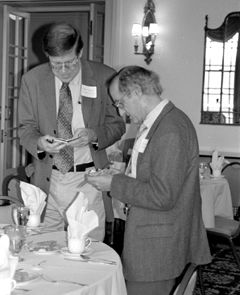The University Record, February 14, 2000 By Mary Jo Frank
Office of Communications

More than a half-century ago, the Regents created a new honorary title—Distinguished University Professor—to recognize stellar faculty members. For the first time in recent memory, the U-M’s current Distinguished University Professors were recognized as individuals and as a group at a Feb. 4 luncheon in their honor.
“We don’t do enough of this simple recognition of the remarkable things that are being done by faculty,” said Provost Nancy Cantor, who read and presented a citation to each honoree. They also will receive personalized engraved glass paperweights.
Earl Lewis, vice provost for academic affairs-graduate studies and dean of the Horace H. Rackham School of Graduate Studies, explained the Regents’ intention that Distinguished University Professors be “provided maximum freedom to pursue scholarly and teaching efforts in a manner calculated to ensure the greatest contribution to the University and the nation.”
Distinguished University Professors receive annual supplements of $3,000 for salary and $5,000 for research. When they retire, They retain the title become Distinguished University Professors Emeriti but the stipends end.
The first eight professorships were created in 1947. As recently as May 1998, the Regents created 12 new positions, bringing the total number to 30. Currently, 20 are filled by active faculty.
Distinguished University Professors exemplify the values, strengths and diversity of the University, Lewis said. They are scholars of great depth and breadth. They also are outstanding teachers and mentors, and are generous in their service to their disciplines, to their schools and colleges, and to the University.
Each Distinguished University Professorship is named for a person of distinction in the same general field of interest as the recipient, preferably a person associated with the U-M. Some Distinguished University Professors have chosen titles based on historical figures, such as Clarence Darrow, who studied at the U-M in 1877–78, and Eliza M. Mosher, one of the first female graduates of the Medical School. Mosher served as the first dean of women from 1896 to 1902. Other Distinguished University Professors have chosen contemporaries such as James Earl Jones, star of stage, screen and television; Theodore M. Newcomb, who established one of the nation’s first doctoral programs in social psychology; and Herbert C. Youtie, who helped establish the U-M’s papyri collection.
Among the active Distinguished University Professors, Minor (Jud) Coon has held the title the longest. He was appointed the Victor C. Vaughan Distinguished University Professor of Biological Chemistry in 1983.
Cantor said she was shocked when she learned that the first woman Distinguished University Professor, Martha J. Vicinus, the Eliza M. Mosher Distinguished University Professor of English, Women’s Studies and History, was not appointed until 1994. Since then, three more women have been named: Rowena G. Matthews, the G. Robert Greenberg Distinguished University Professor of Biological Chemistry in 1995; Huda Akil, the Gardner C. Quarton Distinguished University Professor of Neurosciences in 1999; and Shirley Verrett, the James Earl Jones Distinguished University Professor of Music in 1999.
Following the formal program, Robert Axelrod, the Arthur W. Bromage Distinguished University Professor of Political Science and Public Policy, thanked Cantor, Lewis and others present, saying, “I couldn’t have done what I’ve done without the intellectual and emotional support the University has given us.”
Others honored at the luncheon were Richard D. Alexander, the Theodore H. Hubbell Distinguished University Professor of Evolutionary Biology; William E. Bolcom, the Ross Lee Finney Distinguished University Professor of Music; L. Ross Chambers, the Marvin Felheim Distinguished University Professor of French and Comparative Literature;
Kent V. Flannery, the James B. Griffin Distinguished University Professor of Anthropological Archaeology; Allan F. Gibbard, the Richard B. Brandt Distinguished University Professor of Philosophy; James S. Jackson, the Daniel Katz Distinguished University Professor of Psychology; Yale Kamisar, the Clarence Darrow Distinguished University Professor of Law;
Ludwig Koenen, the Herbert C. Youtie Distinguished University Professor of Papyrology; Vincent Massey, the J. Lawrence Oncley Distinguished University Professor of Biological Chemistry; Gerard A. Mourou, the A. D. Moore Distinguished University Professor of Electrical Engineering and Computer Science; Frederick C. Neidhardt, the Frederick G. Novy Distinguished University Professor Emeritus of Microbiology and Immunology;
Richard E. Nisbett, the Theodore M. Newcomb Distinguished University Professor of Psychology; George I. Shirley, the Joseph Edgar Maddy Distinguished University Professor of Music; Edward E. Smith, the Arthur W. Melton Distinguished University Professor of Psychology; and Walter J. Weber Jr., the Gordon Maskew Fair and Earnest Boyce Distinguished University Professor of Environmental Sciences and Engineering.

